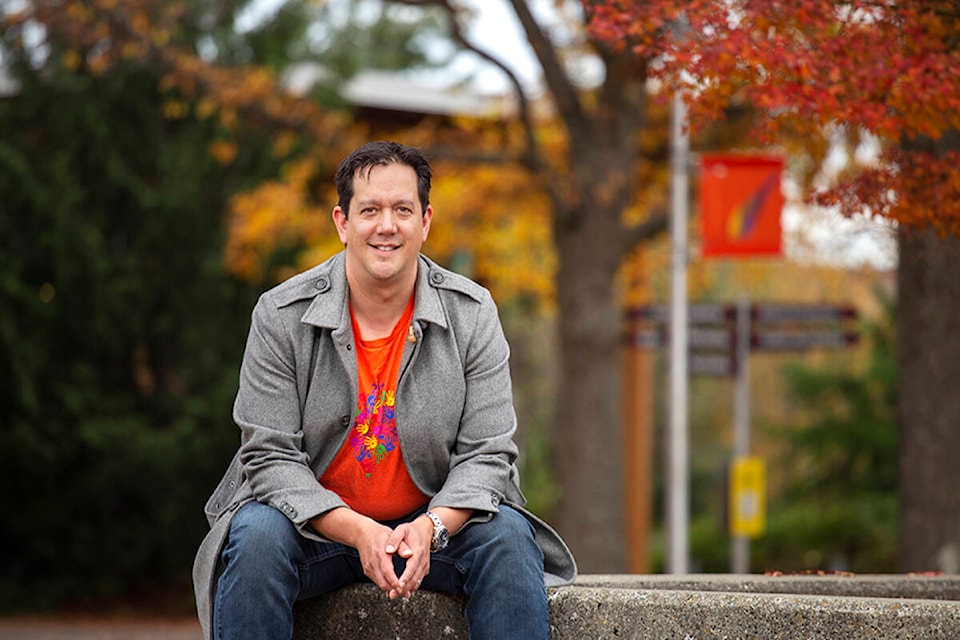Carey Newman is on a coast-to-coast quest to gather the sounds from a dark period of Indigenous history.
Newman, a member of the Kwakwaka’wakw and Coast Salish First Nations who grew up in Sooke, is launching a nationwide appeal for audio submissions from the cultures that were targeted by residential schools.
At the University of Victoria, Newman, who is the Impact chair in Indigenous art practices, collaborates with Kirk McNally, an associate professor of music technology, and a group of Indigenous musicians. Together, they are creating a “soundtrack of resilience” for a virtual reality Witness Blanket.
Newman began work on the original Witness Blanket in 2012, which was made from objects from residential schools, government buildings, and cultural structures he gathered from 77 communities across the country.
“In virtual reality, sound is part of the experience and audio allows people to explore the blanket in a new way,” said Newman, renowned for his work as an artist, carver, and opera singer. “If each of the objects on the Witness Blanket had a voice, what would they sound like? What language would they speak? What songs would they sing?”
One of the reasons the team wanted to add sound to the blanket is to provide another way for people to connect with something tangible, Newman said.
The fact modern technology makes digital sounds indistinguishable from the original source means high-quality recordings can be made by simply using a phone.
One of the questions Newman’s asked frequently is whether people can submit contemporary sounds.
“Absolutely,” he said. “We don’t want to exclude people who have grown up in an urban environment. Culture exists all around us. We want to welcome all kinds of sounds without limitations. If an Indigenous youth is involved in hip hop, for example, maybe those sounds will come from them.”
The fact that people will be able to discover sounds by interacting with the blanket through touch and gestures adds another dimension as well, Newman said.
Olivia Shortt, a storyteller and performing artist from the Anishinaabe, Nipissing First Nation, is creating a composition that will provide another way to explore the blanket.
RELATED: Indigenous artist Carey Newman is a witness to our times
Newman, McNally, and the Indigenous musicians are working on the project with Camosun Innovates, which connects applied learning and applied research, design thinking, interdisciplinary inquiry, productivity improvement, and tech-savvy invention.
“It’s exciting and an honour to work a project created by such a legacy,” McNally said. “The power of the Witness Blanket is evident from the way so many people have engaged with it.”
The creation of the VR Witness Blanket will enable visitors to explore the project with a VR headset, making the experience accessible from coast to coast, said Camosun Innovates director Richard Gale.
“Each of the artifacts tells a different story about residential schools and the children who were impacted during that period,” Gale said.
“Rather than pulling out a drawer and looking at something in a museum, you can reach out and see what each object really looks like in your hand. Collecting sounds will augment the visual impact of the installation, making it more personal, more influential on many levels.”
ALSO READ: Camosun student shares story of overcoming struggles to inspire others
Newman and the team have launched a national appeal for further contributions, this time for sounds instead of objects, in an effort to bring something unique to the VR experience.
Newman hopes participants will contribute auditory artifacts in a similar way to how objects were collected from residential schools for the original Witness Blanket.
“What makes the original Witness Blanket so special is that everyone brought their own idea, which expanded the range of stories we included,” Newman said.
People are invited to record and provide sound that can be woven into the virtual reality experience. Sounds for submissions may include the music of traditional instruments, the sounds of cultural activities such as paddling or carving, and the ambient tones of the natural world like rain or wind, as well as spoken languages, songs, or any other sound associated with someone’s Indigenous culture or community.
Partners for the project include Camosun College, the Canadian Museum for Human Rights, and the University of Victoria.
It is supported by contributions from the College and Community Social Innovation Fund, the Canada Council for the Arts, Telus, and a multi-year grant from the Natural Sciences and Engineering Research Council College and Community Society Innovation Fund.
Visit to make a sound contribution, and for a video on the project.
For more on the original project, visit witnessblanket.ca.



